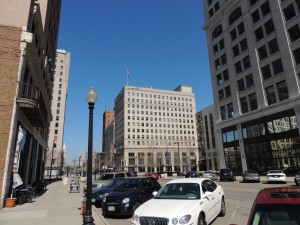On February 25, the NEOSCC Board will be voting on the the Vibrant NEO 2040 Vision, Framework and Action Products. With just under 40 days to the vote and 41 initiatives in the vision, we thought it would be good to create a countdown to the vote. Everyday over the next 5 weeks, we will be sharing an “Initiative A Day” with you so you can gent a better understanding of the vision and framework! If you would like to read all of the Initiatives, you can download them here Vibrant NEO_Recs&Init_010114.
Show your support for Vibrant NEO 2040 by adding your name to our Champions of Vibrant NEO 2040 list here!
These recommendations, initiatives, and products, are not one-size-fits all and some aspects of the initiatives won’t be applicable everywhere in the 12-county region. The Vibrant NEO 2040 Vision, Framework and Products are intended inspire and guide decision-making at the Metropolitan Planning Organization (MPO), Council of Government, and local levels to ensure that land use, transportation, and environmental considerations are simultaneously addressed by their processes. Ultimately, the implementation of Vibrant NEO 2040 is up to Northeast Ohio’s communities and residents. But regardless of the applicability of each initiative to any particular part of the region, the goal for each community within the Vision is the same: stability, prosperity, and a high quality of life for all of its residents.
Recommendation 1: FOCUS NEW RESIDENTIAL AND COMMERCIAL DEVELOPMENT ON SITES WITHIN ESTABLISHED COMMUNITIES
Initiative 1.6: Consider instituting a land value tax to replace existing improvement-based property assessment and taxation methods.
WHAT THIS MEANS. Land value tax is a method of property taxation that is gaining traction in policy circles, though relatively few places have implemented it to date. Most counties and municipalities in the United States in fact employ a method that assesses the improvement value of land, which has the unintended effect of “punishing” more valuable buildings with higher rates of tax. Moving to a land value tax would reverse this, assessing land based on its value within a local and regional market for land, and thus making less productive uses and practices more expensive to maintain from a tax perspective.
The case of a downtown surface parking lot is a good example with which to illustrate the proposition. In such an instance, the owner invests minimally in improvements to a property – merely paving it (which has its own external costs through burdens placed on the stormwater management system, contribution to the urban heat island effect, and so forth) and perhaps constructing a small structure at the point of ingress and egress. The owner earns impressive revenues from the use, owing to the high demand for parking near clusters of employment and leisure destinations, but the only tax he pays is on what the jurisdiction assesses for the paving and the control structure. This incentivizes more entrants into the market for parking, which consumes valuable land and returns ever-lower tax revenues for the jurisdiction. The same principle applies to land speculators, who hold on to land in anticipation of a future appreciation in value, and have no disincentive to prevent a property from falling into disuse and disrepair. For such reasons, even Milton Friedman, the free-market economist who was otherwise deeply skeptical of taxation, once acknowledged that a tax based on the unimproved value of land was the “least bad” to a local economy (Citation: Lincoln Land Institute, Assessing the Theory and Practice of Land Value Taxation, https://www.lincolninst.edu/pubs/dl/1760_983_Assessing%20the%20Theory%20and%20Practice%20of%20Land%20Value%20Taxation.pdf).
WHY THIS IS IMPORTANT. Land value taxes align incentives in a manner that encourages better market outcomes and thus benefits municipalities financially in the long run. The case of Pittsburgh stands as the best example of this practice in a major metropolitan area. From 1913 until the city-county consolidation of the property assessment function in 2001, Pittsburgh employed a two-tiered property tax system. Land was assessed at a higher rate than the improvement (by nearly five times), which incentivized more intensive development in higher-value quarters of the city and kept at bay the speculative financial practices that led to foreclosure crises and perpetually vacant land in many other American cities. This, more than any other public policy factor, is responsible for the stabilization and modernization of the Pittsburgh region’s core, especially in the critical decades spanning the transition to a postindustrial economy (Citation: Oates, Wallace E. and Schwab, Robert M. “The impact of urban land taxation: the Pittsburgh experience.” 50 National Tax Journal 1-21 (March 1997)).
Northeast Ohio communities would do well to consider a land value-based tax, particularly to encourage developers to deliver projects that make the highest and best use of urban land, and to set up the stage to capture back some of the value appreciation due to investments in transit infrastructure and public realm improvements.
GETTING IT DONE. This initiative relies on taxing entities understanding and coming to agreement on the fact that a tax on land value constitutes a suitable and beneficial basis for property assessment and taxation, seeking clarification from and advocating for change if necessary in state law; and having the will to retrain or retool assessment departments as needed. Municipalities, townships, and counties will ultimately need to lead this process. Taxing power ultimately rests with them and they have the most to gain in encouraging better development outcomes. NEOSCC and regional planning partners could help to catalyze the process by studying the proposition further and convening a regional discussion roundtable of local government partners to deliberate on the feasibility of its implementation. Local universities with public policy and economic development research institutes may also be a technical and organizational resource on this initiative.
Lead |
Municipalities, Townships, Counties |
Target Community |
Strategic investment areas, asset risk areas, cost risk areas |
Implementation Complexity |
High |

